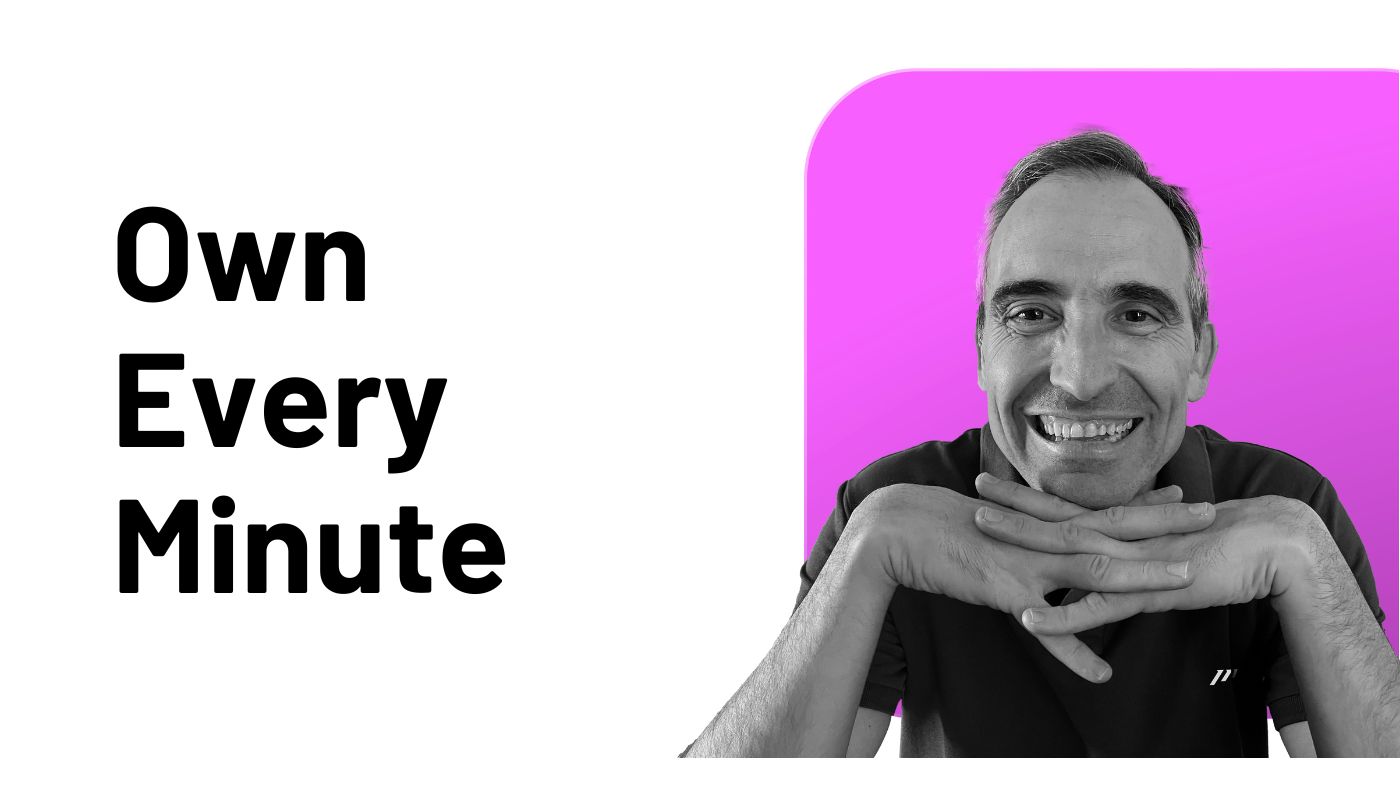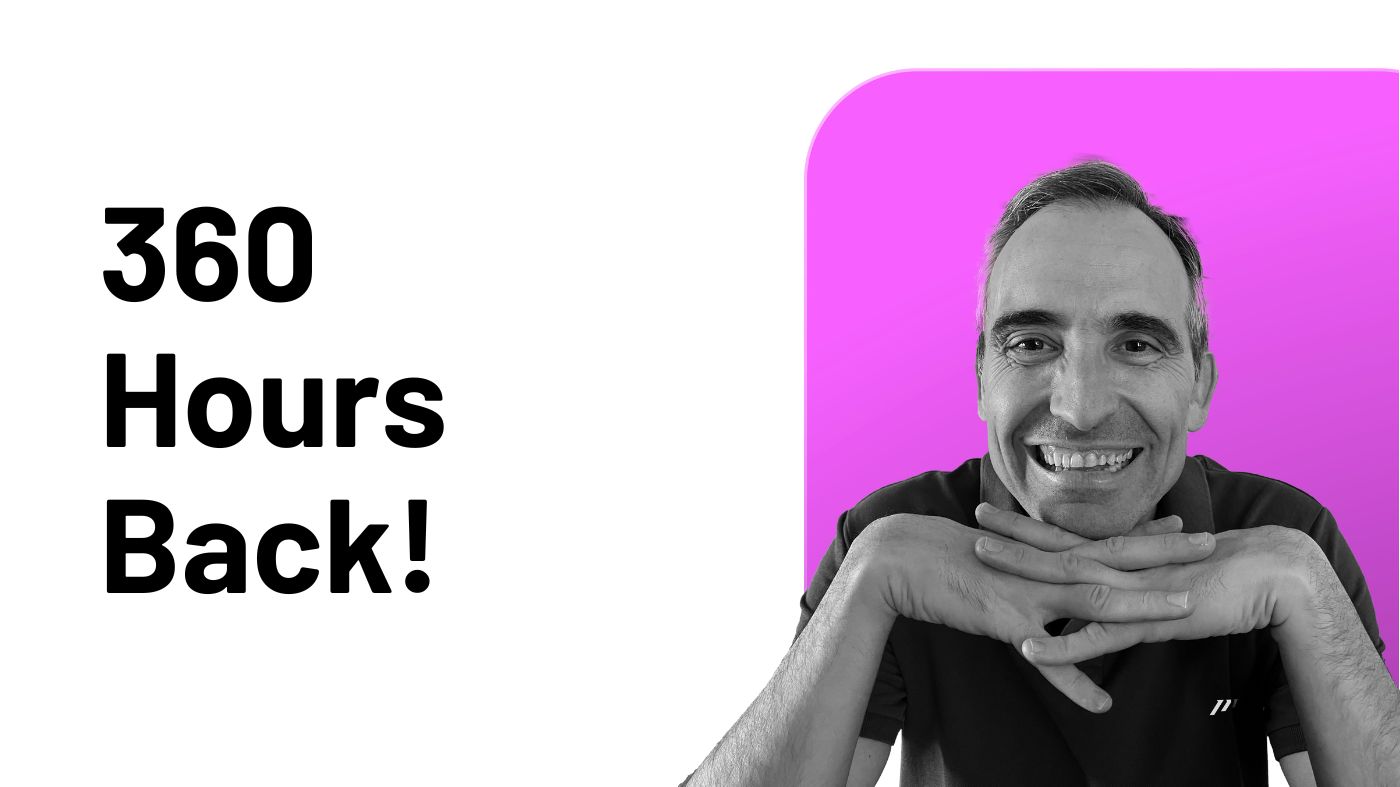Most people grow up chasing money. I grew up chasing time.
I still remember hearing “Time is money” for the first time as a kid.
Money was easy to understand. You could touch it. Count it. Trade it.
Time?
Time was strange. Invisible. Mysterious. And I loved it.
That’s where the obsession began.
When I was just six, I learned the concept of time scarcity in the most personal way.
My mother worked at a casino, long hours, tight schedules.
The little time we had to play together was rare and precious.
That’s when I learned how to read a clock, not in school, but in real life.
Not because I had to. Because I wanted to know exactly how much time we had left.
By the age of eight, I was drawing up my own study timetables, just to earn a few extra hours of freedom in the afternoon.
I wanted to finish my homework early so I could go out to the street and play with my friends.
That may sound reckless today, but back then (the 80s), those hours outside gave me more useful knowledge about people and the world than most of what I was learning in books.
I wasn’t trying to be productive. I was just trying to make time mine.
And yet, even with that early obsession, I would later struggle with one of the most well-known tools for managing time: the Eisenhower Matrix.
Like many professionals, I thought it would be the key to separating what really matters from the noise. But the more I tried to use it by the book, the less it worked.
This article is not about giving up on it. It’s about showing you how to make it actually work in your business life. With a simpler, smarter approach that tackles the two real challenges: urgency and importance.
Why Most Professionals Feel in Control While Losing Time Every Day
Busy professionals often live under a dangerous illusion.
They believe they’re in control because their calendar is full, their inbox is active, and their to-do list is endless.
But here’s the truth: being busy is not the same as being in control.
In fact, I’ve seen hundreds of professionals who are constantly working but still feel like they’re falling behind.
They spend the day reacting, jumping from meeting to meeting, responding to whatever screams the loudest. And when the day ends, they’re exhausted but unsure if they actually moved forward.
That’s not control. That’s chaos wearing a suit.
Science backs this up.
Studies in cognitive psychology show that when we’re overwhelmed, we default to urgency over importance.
It’s called the urgency effect, a mental bias where we prioritize tasks with short deadlines even when they don’t really matter.
Our brains confuse motion with progress.
“Time is what we want most, but what we use worst.” — William Penn
But, it gets even worse.
Each task switch, each decision, each interruption carries a cognitive cost.
According to research published in the Journal of Experimental Psychology, even brief mental shifts reduce our efficiency by up to 40 percent.
That means nearly half of your productive time disappears.
Not because you’re not working hard, but because you’re working without a structure that protects your attention.
This is where most productivity methodologies and tools fall short.
They help you “organize” your chaos, but they don’t help you escape it. And frameworks like the Eisenhower Matrix are often misunderstood, misapplied, or quickly abandoned.
The goal is not to add complexity.
The goal is to give you a way to make better decisions under pressure. To distinguish clearly between what deserves your focus now, what can wait, and what’s just noise.
That’s how you start turning time into your most valuable business asset.
What Running a Global Agency Taught Me About Real-Time Pressure
If you want to understand what time pressure really means, try running corporate events.
Twenty-three years ago, I founded a global marketing agency.
One of our core services has always been organizing high-level events for major brands. And there’s one non-negotiable rule in that world: the event starts on time.
No delays. No excuses. No flexibility.
You’re either ready, or you’re not.
That reality taught me more about time than any productivity tool, hack, or methodology ever could.
When you’re managing dozens of suppliers, a technical team, stage lighting, speakers, catering, and the client’s expectations, everything must align at a precise moment.
Not five minutes later. Not almost done. Done.
“Lost time is never found again.” — Benjamin Franklin
This environment forced me to learn the hard way the difference between what is urgent and what is important.
When you’re juggling moving parts, you realize that not everything deserves your attention. Some problems are loud but irrelevant. Others are quiet but critical.
That’s when I revisited the Eisenhower Matrix.
I had seen it before. I had tried to use it like the books said.
But honestly, I couldn’t make it work. Not in the real world.
It always felt too rigid, too disconnected from what was actually happening around me.
But I kept thinking about the two things it tries to separate: urgency and importance. And that’s when things started to change.
I realized I didn’t need the Matrix to work perfectly.
I just needed a better way to filter those two variables in a way that fit my actual life and business.
That shift is what made all the difference, and that’s what I want to share with you in this article.
Why Most Productivity Hacks Break When Time Gets Real
If you’ve ever tried to use the Eisenhower Matrix and felt like it didn’t work for you, you’re not alone.
As I told you before, it didn’t work for me either.
And I’ve seen it fail for dozens of professionals who truly wanted to take control of their time. Not because the idea is wrong, but because real life is more complex than four boxes on a piece of paper.
When you’re managing clients, leading teams, handling operations, and making strategic decisions, nothing falls cleanly into one category.
Urgent tasks often feel important. Important work often comes with pressure.
And too often, the matrix becomes a theoretical exercise instead of a daily decision-making tool.
That’s the problem with most productivity hacks. They assume ideal conditions. They give you perfect frameworks, but they don’t survive contact with reality.
What I’ve learned is that the Eisenhower Matrix only works when you stop trying to use it as a rulebook.
Instead, you need to take its principles (urgency and importance) and integrate them into how you actually think, plan, and act each day.
This means adapting the framework to your business context.
It means recognizing how time behaves under pressure.
And it means building a decision-making process that accounts for the emotional weight of urgent tasks and the long-term value of important ones.
The solution isn’t to throw out the matrix. It’s to reshape it into something useful, flexible, and easy to apply under real conditions.
Let me show you exactly how I did that.
How I Made the Eisenhower Matrix Actually Work
For years, I treated the Eisenhower Matrix like a formula.
Four boxes. Two axes. A clean distinction between what’s urgent and what’s important. It looked brilliant on paper.
But in practice, it never worked.
It was too rigid, too theoretical, and too disconnected from how time behaves in the real world.
I tried to fit everything into the boxes, hoping clarity would follow.
But instead of feeling more in control, I felt stuck, more focused on labeling tasks than moving forward with confidence.
The shift came when I stopped trying to make the matrix work the way it’s taught.
Instead, I focused on the two concepts it’s built to clarify: urgency and importance.
That changed everything.
Once I truly internalized those two filters, I started bringing them into every part of my productivity system.
Not just as an occasional analysis tool, but as a daily mindset.
Every decision, every planning session, every review, filtered through these two lenses.
I stopped asking, “Where does this fit in the matrix?” and started asking:
-
Is this really urgent?
-
Is this truly important?
For example, when a client would request last-minute changes to an event presentation, instead of automatically labeling it “urgent and important” and dropping everything, I’d ask:
-
Will this significantly impact the outcome?
-
Can this wait until after I finish the current priority?
It became natural. I didn’t need the diagram anymore. I had internalized the thinking behind it.
And because it was embedded in my productivity system, those filters guided me automatically.
I no longer had to fight the chaos. I had a way to face it with clarity.
That’s when the matrix finally made sense. Not because I mastered the model, but because I mastered the message behind it.
Now, let me break down exactly how you can do the same.
How to Make Importance Work in Real Life
Most productivity advice fails because it stays on the surface.
It’s easy to understand, but incredibly hard to apply in the middle of a chaotic business day.
You don’t have time to draw diagrams or label tasks. You’re making decisions on the fly, managing people, handling setbacks, and switching contexts constantly.
That’s why the Matrix only works when it’s embedded into your productivity system. Not as a diagram, but as a filter that runs silently in the background.
Urgency and importance should not be something you analyze once a week. They should be part of your thinking every time you decide what to do next.
That only happens when your productivity system is designed to support it.
This is where most professionals struggle.
They understand the idea, but they never connect it to how they actually work. And so the Matrix fades into theory, while their time keeps being consumed by noise.
Let’s change that.
“You will never find time for anything. If you want time you must make it.” — Charles Buxton
You don’t need to categorize every task or build a perfect matrix. That kind of complexity turns into work about work. I’ve tried it. Many times. It doesn’t hold up in the middle of a fast-moving day.
What actually works is this: set clear Weekly Goals and make time for Deep Work.
That’s how you bring importance into your productivity system, work, and life without slowing yourself down.
Start by defining your long-term goals.
These are the outcomes that matter. They give direction and clarity.
But most professionals stop there. That’s why they stay stuck reacting to whatever seems urgent.
The key is translating your goals into execution.
Every week, define five Weekly Goals.
These are the specific tasks that, if completed, move your most important goals forward. They’re not reactive. They’re intentional. They bring importance into your week in a way that’s clear and actionable.
For instance, one of my Weekly Goals might be “Finalize Q3 marketing strategy” rather than the vague “Work on marketing.”
This specificity makes importance concrete and achievable.
Now comes the most critical step.
Schedule daily Deep Work sessions in your planner to tackle these Weekly Goals.
I recommend placing them first thing in the morning. That’s when your energy is highest and distractions are lowest.
If you protect that time, you guarantee that the important work gets done, no matter what surprises the day throws at you.
In practice, this means blocking 2-3 hours each morning before opening your email or attending meetings.
I personally use 8:30-11:00 AM for my Deep Work.
This is how you create consistency without rigidity. You’re not managing tasks. You’re protecting momentum.
By focusing on five Weekly Goals and locking in Deep Work sessions, you embed importance into your productivity system and the way you naturally work.
Urgent things will still come up. They always do. But now, they won’t control your entire day.
You’ll have already taken care of what matters most.
Now, let’s tackle the other half of the equation.
How to Handle Urgency Without Losing Control
Urgency is the silent killer of every productivity system.
If you don’t define it clearly, everything feels urgent. And when everything feels urgent, nothing truly important gets done.
In ICOR®, the methodology we’ve created at the Paperless Movement® to help busy professionals design, build, and implement a productivity system with any tools, we define urgency with precision: An urgent task is one that, if not completed immediately, will cause a significant problem in the business.
That’s the baseline. That’s the mindset you need to internalize and share with your team.
Not everything is urgent.
If a task doesn’t meet that threshold, then it’s not urgent.
It may feel intense, it may be coming from someone important, but that doesn’t make it urgent.
In those cases, your team should stick to the priorities agreed in the weekly Agenda Meeting, guided by the Weekly Goals. Those are the tasks that take care of importance, not urgency.
Here’s a concrete example: When a client emails with “URGENT” in the subject line asking for data they could have requested days ago, that’s not automatically urgent by our definition.
Instead of dropping everything, we might respond: “We’ve received your request and will deliver it by end of the day,” then continue with our planned priorities.
Once you’ve mastered that distinction, the next step is even more powerful: bring urgency into your time management mindset.
Every time a new task comes in, ask yourself:
-
When should this be done?
-
When would this become urgent if left unattended?
This mental habit positions you ahead of the chaos.
You start anticipating problems before they explode.
You schedule tasks as they arise, with intent and clarity.
And when that scheduled time comes, you ask yourself again: Does it still make sense to do this now?
This is how you build a productivity system that flexes with your reality.
A productivity system that protects your time while adapting to constant change.
Because the truth is, most urgent tasks fade into nothing. What felt like a fire today often becomes irrelevant tomorrow.
That’s why urgency must be treated objectively. You need a clear line.
If the task doesn’t meet the urgency threshold, you delay it.
No guilt. No hesitation. Just smart execution.
And here’s a final rule I’ve learned to live by: If you hesitate, delay.
That hesitation is a signal.
Your productivity system is trying to protect you from overreacting.
Urgency also does not mean immediately.
In fact, it almost never means you must stop what you’re doing.
So whenever something labeled “urgent” comes up, double check:
-
Is this really urgent?
-
Can this wait until after my Deep Work session?
-
Would delaying this by two hours really cause a problem?
You’ll be surprised how often the answer is NO.
When you handle urgency this way, you don’t just gain control. You gain peace of mind. You stop reacting. You start choosing.
And that’s when your productivity system becomes a reflection of how you want to lead, not how the world tries to pull you.
In the final section, we’ll wrap everything up and take one final look at why time isn’t just a concept to manage. It’s the foundation everything else rests on.
Time Isn’t Just an Asset: It’s Your Operating System
We often hear that time is our most valuable resource. But the truth is, time is much more than that.
Time is the operating system of your life and business.
Everything runs on top of it: your strategy, your team, your decisions, your goals.
If you don’t master it, nothing else can reach its full potential.
That’s why this article wasn’t just about the Eisenhower Matrix. It was about learning how to truly make time work for you.
Not through hacks, not through complexity, but by bringing two concepts (urgency and importance) into the core of how you operate every day.
“The future is something which everyone reaches at the rate of sixty minutes an hour.” — C.S. Lewis
I didn’t learn this by reading books.
I learned it by failing, building companies, leading teams, managing crises, and fighting for clarity in the middle of chaos.
And what worked wasn’t theory. What worked was embedding simple, powerful concepts and workflows into a productivity system that adapts to real life:
-
Define your Weekly Goals.
-
Protect Deep Work time for the important.
-
Redefine urgency, and stop letting it dictate your days.
-
Ask better questions. Make better decisions.
-
Let your productivity system do the heavy lifting.
This is how you stop running in circles and start building momentum.
Remember that six-year-old boy who learned to read a clock just to know how much precious time he had left with his mother? He grew up to deeply think, design, and build a productivity system that doesn’t just manage time: it honors it.
When time becomes your ally, everything changes.
You gain control. You make progress. And most important of all, you create space to focus on what actually matters: to you, to your business, and to the people who count on you.
Because time isn’t just an asset. It’s the invisible force that either drives your success forward or quietly steals it away.
Choose to make it your operating system. And never look back.




